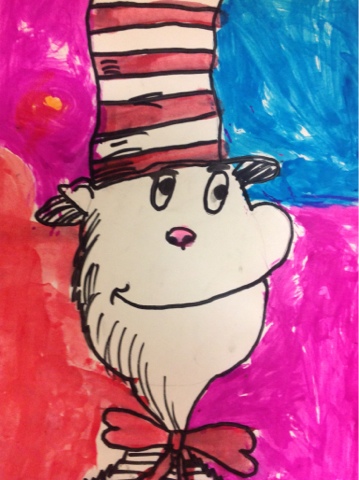First graders learned about the french artist Henri Mattise. He lived from 1869-1972. He grew up wanting to be a lawyer and did not begin painting until he was 20 years old. After painting for the first time, he declared that for the first time in his life, he was not bored. He quit law school and became an artist. Matisse loved color and painted the colors he felt, not the colors he saw. An art critique said that he painted like a wild beast or in French- les Fauves. Matisse therefore was part of an art movement known as fauvism. We looked closely at his painting of goldfish and tried to replicate it, but using the colors we liked.
Friday, March 22, 2013
Tuesday, March 19, 2013
3rd grade value and form drawings
3rd graders studied the difference between two-dimensional and three-dimensional objects in art. Together we drew three forms-- a cube, a sphere and a cylinder. We then discussed how light affects and changes the way things look. We imagine the sun was shining in the top fit corner of our drawing and after completing a value scale in pencil, we shaded our forms. The last part was the background. Using only one marker, we created an abstract design that was 50/50 white/color of our choice.
Illuminated Letters
Third graders studied Ireland's Book of Kells. We learned that reading is something that most people didn't know how to do. We also discussed the process of making a book from the parchmenter, the scribe to the illuminator. Our illuminated letters feature the first letter of our first name and the designs around the letter tell the viewer about the things we like. We made this with metallic markers, trying to replicate the glowing gold leaf in the real illuminated letters.
Monday, March 18, 2013
4th grade ceiling scrapers
4th graders, with the help of Architecture Adventure, are recreating sixteen iconic skyscrapers from the Chicago skyline. We are using recycled boxes and paper mâché. These are all a work in progress. Students are working in teams with five students per building and using reference photos, are recreating as many details as possible out of cardboard for the skyscrapers.
5th grade presidents
Here are some more of the 5th grade clay presidents. These guys are drying and will be ready for the kiln later this week.
Wednesday, March 13, 2013
2nd grade coil tiles
2nd graders talked about what it means when artwork is asymmetrically balanced. Even though the left side is different than the right side, they are still visually balanced. Our designs are asymmetrical. We began by rolling out clay ropes or clay snakes, paying careful attention to the thickness of the clay--no thicker or thinner than your pointer finger. Using a 6x6 inch piece of paper as a template, we rolled coils and placed them along the perimeter of the paper and rolled out a variety of coils to create our design in the square. We curled our coils into spirals, zig-zags, and "s" and placed them as closely together as possible. After firing, we used tempera paint to paint these, but then wiped off most of the paint with paper towels to create value, or lights and darks of our chosen color.
Saturday, March 9, 2013
Happy birthday Dr. Suess, from kindergarten
Kindergarteners looked at the life and art Dr. Suess. He was both an author and illustrator of 44 books. We read "Cat in the Hat" and carefully observed the cat. We identified shapes we could see--lots of ovals. And then following directions we drew the cat, step-by-step. We began with a a large oval and added shapes learned about overlapping shapes. We added texture to our cat by cross hatching or adding short little texture lines just like Dr. Suess.
Sunday, March 3, 2013
2nd grade penguins
2nd graders learned about the lives of emperor penguins. We also learned that color has temperature. Red, yellow and orange look like they are warm. While blue and purple appear cold. After drawing our penguins and outlining in sharpie, we used watercolors to paint. We learned a watercolor technique called 'wet on wet' where paint runs and bleeds and colors mix together al out magically. Lastly, we sprinkled table salt on our penguins to soak up a tiny bit of watercolor and add some cool texture to our paintings.
Subscribe to:
Posts (Atom)



































